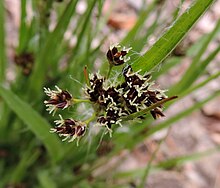Luzula multiflora
Appearance
| Luzula multiflora | |
|---|---|

| |
| Scientific classification | |
| Kingdom: | Plantae |
| Clade: | Tracheophytes |
| Clade: | Angiosperms |
| Clade: | Monocots |
| Clade: | Commelinids |
| Order: | Poales |
| Family: | Juncaceae |
| Genus: | Luzula |
| Species: | L. multiflora
|
| Binomial name | |
| Luzula multiflora | |
| Synonyms[1] | |
| |
Luzula multiflora, the common woodrush[2] or heath wood-rush,[3] is a species of flowering plant in the rush family.
It is native to Europe, eastern Asia, northern Africa, northern North America, including Canada, and in northern regions of the United States.[1]

It grows 10 to 40 cm (4 to 16 in) tall with basal leaves 3.5 to 12 cm (1+3⁄8 to 4+3⁄4 in) long and 2 to 6 mm (0.08 to 0.24 in) wide. The flowers have six brown to black tepals 2 to 4 mm (0.08 to 0.16 in) long.[4]
References
- ^ a b "Luzula multiflora". Germplasm Resources Information Network. Agricultural Research Service, United States Department of Agriculture. Retrieved 2018-08-01.
- ^ USDA, NRCS (n.d.). "Luzula multiflora". The PLANTS Database (plants.usda.gov). Greensboro, North Carolina: National Plant Data Team. Retrieved 24 June 2015.
- ^ "BSBI List 2007". Botanical Society of Britain and Ireland. Archived from the original (xls) on 2015-01-25. Retrieved 2014-10-17.
{{cite web}}: Unknown parameter|deadurl=ignored (|url-status=suggested) (help) - ^ Swab, Janice Coffey (2000). "Luzula multiflora". In Flora of North America Editorial Committee (ed.). Flora of North America North of Mexico (FNA). Vol. 22. New York and Oxford: Oxford University Press – via eFloras.org, Missouri Botanical Garden, St. Louis, MO & Harvard University Herbaria, Cambridge, MA.
- Lejeune, Alexandre Louis Simon (1811). Flore des Environs de Spa. Vol. 1. p. 169.
- Kirschner, J. (1990). "Luzula multiflora and allied species (Juncaceae): a nomenclatural study". Taxon. 39: 106–114. doi:10.2307/1223198.
- Kirschner, J. (2001). "(1500) Proposal to conserve the name Luzula multiflora (Juncaceae)". Taxon. 50: 1190–1191. doi:10.2307/1224743.
External links
- NatureServ: Luzula multiflora subspecies info-listings
 Data related to Luzula multiflora at Wikispecies
Data related to Luzula multiflora at Wikispecies
Wikimedia Commons has media related to Luzula multiflora.
Categories:
- Luzula
- Flora of Canada
- Flora of the Northern United States
- Flora of the Northeastern United States
- Flora of the Northwestern United States
- Flora of the Southwestern United States
- Flora of the Appalachian Mountains
- Flora of the Great Lakes region (North America)
- Flora of the Rocky Mountains
- Flora of California
- Plants described in 1794
- Poales stubs
